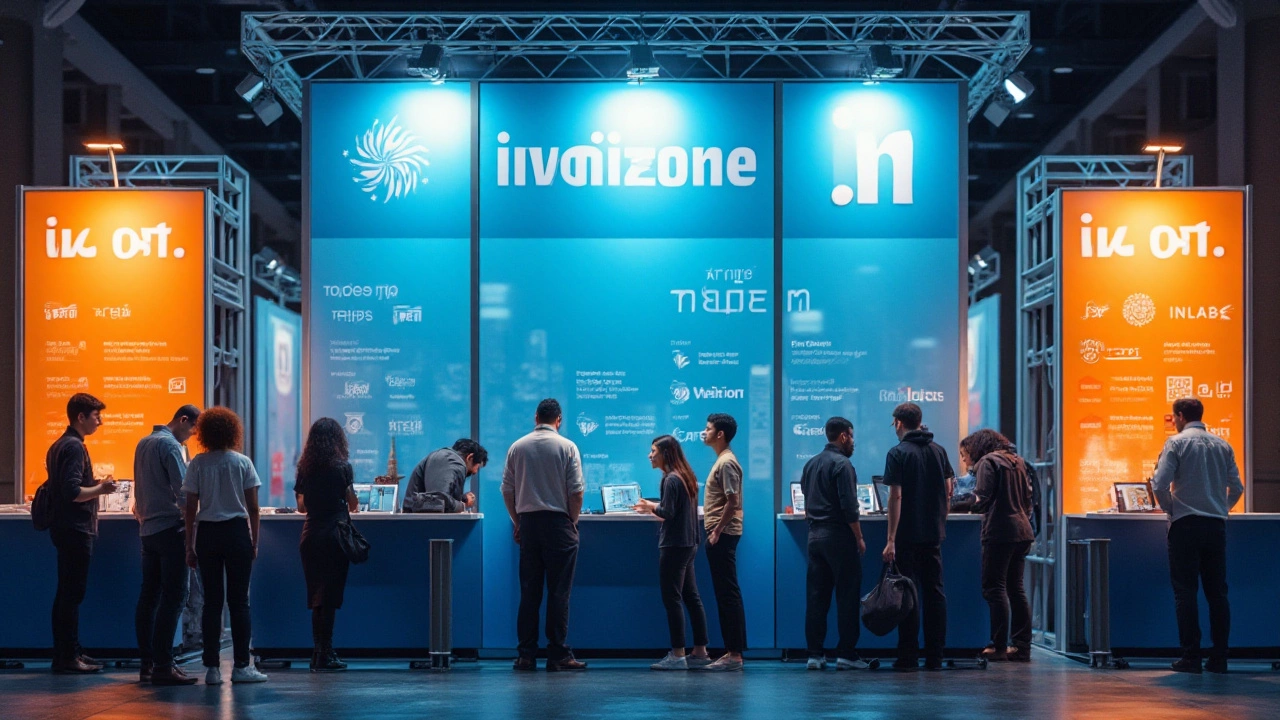When one thinks of the .in domain, India often comes to mind. It's the internet country code top-level domain (ccTLD) for the Republic of India, much like how .uk stands for the United Kingdom. But, the perception that it is solely for Indian entities is something worth exploring further. As the digital landscape broadens, there’s more to these letters than meets the eye.
The .in domain represents opportunities not only for Indian enterprises but for a global community looking to tap into this dynamic market. It provides an edge in local SEO and offers brand protection against potential cybersquatting. Interestingly, entities outside India are progressively capitalizing on the utility of the .in domain through creative marketing strategies. Such moves demonstrate the domain's potential as more than just an identifier of location.
- The .in Domain: A Brief Overview
- Benefits of Using a .in Domain
- Global Usage of .in Domains
- How to Register and Use a .in Domain
The .in Domain: A Brief Overview
The .in domain, being the ccTLD for India, plays a crucial role in the digital identity of Indian websites. With the emerging boom in technology and internet accessibility, India has marked its presence significantly on the web, which is mirrored through the usage of the .in domain. This domain was introduced in 1989, instantly establishing a linguistic connection for users and creators alike, giving a digital address that resonates culturally and geographically.
The utility of the .in domain has evolved significantly, and today it’s not just about providing an online identity tied to an Indian presence. The domain is controlled by the National Internet Exchange of India (NIXI) which ensures the registration process is smooth and cost-effective. Businesses, both local and international, value the domain for branding and search optimization. An interesting fact is that there was a substantial surge in registrations right after the liberalization of regulations in 2005, allowing individuals and companies outside India to secure their own India domain.
Navigating through the rules laid out by registry operators, it is quite clear why many global companies opt for this extension; it's not restricted to Indian residents or organizations. With about 2 million .in registrations by 2023, it accounts for significant internet real estate, showcasing not only its growing adaptation but also its acceptance as a versatile online identity. In fact, prominent brands utilize .in domains for targeting the Indian market without having physical operations there. According to a statement by a NIXI official,
"The essence of the .in domain lies in its dual capacity to promote local culture while also acting as a gateway for international entities to connect with one of the world's largest markets."It's interesting how this digital namespace effectively merges international ambitions with national pride, driving an economy poised for digital leadership.
While some might question the limitation due to its regional ties, the benefits seem to outweigh these concerns, which is why the .in domain sees so much embrace. Whether you are a new business looking to establish a presence in the diverse subcontinent or a multinational aiming to enhance local connectivity, this domain can serve various strategic goals. The significance of domain hosting, conveniently available and supported in numerous languages, adds to the compelling narrative of India stepping toward a self-reliant digital ecosystem.

Benefits of Using a .in Domain
Choosing a .in domain can be a smart move for individuals and businesses looking for the right digital face. Not only does this domain resonate strongly with local audiences in India, but it also makes international ventures stand out by leveraging the growing recognition of India's market. This domain offers a level of trust and authenticity, being aligned with one of the world's fastest-growing economies. Companies opting for India domain extensions often experience enhanced search visibility within the region, as search engines tend to favor local ccTLDs when providing location-specific results, thereby increasing their organic reach effectively.
Another advantage of the .in domain is the relatively larger pool of available names compared to more saturated domains like .com. This opens avenues for creativity and originality, allowing registrants to select names that can clearly communicate their brand message without the clutter typically associated with more conventional choices. Furthermore, the .in domain can be used creatively to form witty domain hacks or memorable web addresses, which can leave a lasting impression on users. It's a unique way to stand out in a crowded digital marketplace.
"The .in domain gives businesses an opportunity to showcase their dedication to the Indian market, capitalizing on a region that's seen exponential growth in online activities," says tech entrepreneur Shreya Gupta.
The competitive registration fees associated with the domain also play a role in its adoption. Start-ups, small businesses, and even larger organizations find the cost-effective nature appealing when balancing budgets for digital assets. The .in domain allows entities to allocate resources efficiently while still maintaining a strong online presence that appeals to local and international customers alike.
SEO and Brand Recognition
Utilizing a .in domain addresses a dual objective of brand penetration and SEO effectiveness. As Indian citizens increasingly engage with e-commerce and digital services, having an India-specific domain can initiate stronger connections, fostering trust and consumer confidence. Indian customers are likely to favor a website with a .in suffix during their browsing sessions, translating into better engagement metrics and potentially higher conversion rates. Beyond borders, it helps businesses who want to market their products with an Indian dimension, leveraging cultural nuances to attract a global audience interested in India's vast array of offerings.Strategic Marketing Advantages
For those outside India, the potential for strategic marketing using the .in domain is vast. Organizations can utilize it to create specific campaigns targeting an Indian demographic or present themselves as international brands that hold clout in the Indian market. Think of connecting with Indian culture, festivals, and consumer behavior while planning promotions—a worthwhile endeavor given India's burgeoning internet population. Incorporating the .in domain provides an air of legitimacy when crafting targeted content, indicating an invested interest in India's market dynamics.Additionally, the technical infrastructure supporting the .in domain is robust, managed by the National Internet Exchange of India (NIXI), ensuring reliability and security. With such a solid foundation, businesses can confidently build scalable platforms that are equipped to handle growing traffic and data securely. This mix of strategic benefits and technical assurance makes the .in domain not just a label of identity but a tool of advantageous possibilities in the digital realm.

Global Usage of .in Domains
The idea of a .in domain being used predominantly within India is a notion that has been gradually changing over the years. Businesses from around the world have come to recognize the potential embedded within this specific country code top-level domain. One might wonder, why would a company outside of India be interested in a .in domain? The reasons are varied and deeply rooted in both strategic marketing and domain availability. Many global corporations and brands use the .in domain to establish their online presence in India without having a physical office in the country. It allows them to cater to an Indian audience directly while benefiting from localized SEO strategies.
Interestingly, the .in domain is also favored by tech-savvy entrepreneurs and startups looking to create a unique identity. With businesses becoming more global, having a website that resonates with the Indian market can be a significant advantage. Marketers often leverage this domain to suggest a sense of affinity with India, to appeal to local sentiments, or position their brand as 'inclusive' of one of the world's largest consumer markets. There’s a famous case where a startup partially based in Silicon Valley opted for the .in domain to signify innovation, using 'in' as the English preposition, thus adding a creative twist to their branding.
“The .in domain is not just about location; it's about an invitation, an intent to be inclusive in a global marketplace,” remarked John Smith, a senior digital strategist at Domain Experts.Such creative usage underscores a universal shift in how digital identities are perceived. Intriguingly, domain hacks have found their spotlight here as well, where the .in domain is embedded into meaningful terms or phrases. This practice can be seen in various online communities fostering both intrigue and recall, allowing brands to stand out uniquely in a crowded digital space.
Despite these global trends, it's important to note how the website hosting industries are evolving around such domains. The practicality of registering a .in domain is relatively straightforward, with many international hosting services providing seamless registration processes for non-Indian residents. This ease of access has fueled increased global interest, with many seeing it as a viable alternative due to the saturation of more common domains like .com. Interestingly, data suggests that there has been a steady increase in the number of .in domains registered outside India, a testament to its growing popularity.

How to Register and Use a .in Domain
Stepping into the realm of domain registration, especially for a .in domain, offers a blend of bureaucratic procedure and creative expression. This process can be straightforward once familiarized with the steps involved. Many wonder if they must reside in India to possess such a domain, but the .in domain is accessible globally. The first step is to select a reputable domain registrar approved by the National Internet Exchange of India (NIXI). A good strategy is to shortlist a few registrars and compare their features and pricing to find the best fit. Look for registrars that are known for stability and customer support, as the initial selection often has long-term implications.
Once you've settled on a registrar, it's time to choose your desired domain name. Engaging in this part of the process involves both art and strategy. The name should ideally be concise, memorable, and relevant to your business or personal branding goals. Here, a dash of creativity can make a significant difference, especially given how some of the most obvious names are often already taken. After choosing a name, the next step is to check its availability and to consider alternatives in case your first choice isn’t available. Upon finding an available name, the registration process begins, which includes filling out required details and completing payment. The registration period for a .in domain typically ranges from one to 10 years, allowing flexibility for both short-term projects and long-term commitments.
Once you’ve successfully registered your .in domain, attention shifts to its use and integration into your digital strategy. This is where creativity really comes into play, and understanding domain pointing and DNS settings becomes essential. Pointing your domain to a hosting provider is crucial for making your website live. This involves setting the domain’s DNS records, which can be a complex task for newcomers. Fortunately, most registrars provide step-by-step guides and customer support to ease the setup process.
As noted by the Times of India in a tech feature, "Leverage the local relevance of the .in space to enhance your digital identity effectively."This nods to the power of using a geographically significant domain to boost recognition and trust among local users.
Furthermore, it's important to protect your investment by securing additional similar domains to prevent competitors from infringing on your brand. If your business plans on scaling internationally, consider acquiring both regional and global domains that can redirect to your primary site with the .in domain. Finally, to fully capitalize on your .in domain, ensure that your website content also resonates with Indian cultural and linguistic nuances if targeting the Indian market. Utilizing local SEO strategies and crafting culturally rich content can drastically improve your website’s visibility and engagement.
